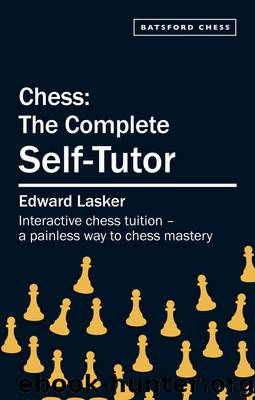Chess by Edward Lasker

Author:Edward Lasker
Language: eng
Format: epub
Publisher: Pavilion Books
Published: 2014-10-28T04:00:00+00:00
3...c5, being an ideal developing move, should be playable, but the move ...d6, if made before castling, would not really strengthen the centre, because it would nullify the protection given it by the knight, which is pinned as soon as the d-pawn advances. It would be different if you first played 3...a6 and answered 4 a4 with 4...c5. Then, as I pointed out, you could unpin your knight with ...b5 when it is needed to protect your e-pawn. This defence, ...c5 preceded by ...a6, was tried in a number of tournaments by Alexander Alekhine, the Russian player who was world champion from 1927 to 1935 and from 1937 until his death in 1946. He played the opening against me in the New York tournament of 1924, and to avoid all of his extensive analyses I answered 4...c3 with 5 d3, being satisfied with the advantage of the first move rather than attacking the black centre with c3 and d4. The latter continuation is naturally the one he had expected. It is unquestionably the strongest.
If, in Diagram 317, White plays 4 c3, you face a problem similar to the one you encountered in the Giuoco Piano in Diagram 311 (section 102). Of the moves suggested there, 4...f6 would again be best, because it is the most natural developing move, preparing for castling and attacking White’s centre pawn. Play could continue the same way as in the Giuoco Piano: 5 d4 exd4 6 cxd4 b4+ 7 d2 xd2+ 8 bxd2 d5 (Diagram 318).
Download
This site does not store any files on its server. We only index and link to content provided by other sites. Please contact the content providers to delete copyright contents if any and email us, we'll remove relevant links or contents immediately.
| Coloring Books for Grown-Ups | Humor |
| Movies | Performing Arts |
| Pop Culture | Puzzles & Games |
| Radio | Sheet Music & Scores |
| Television | Trivia & Fun Facts |
The Infinite Retina by Robert Scoble Irena Cronin(6164)
Harry Potter and the Cursed Child: The Journey by Harry Potter Theatrical Productions(4440)
The Sports Rules Book by Human Kinetics(4290)
Molly's Game: From Hollywood's Elite to Wall Street's Billionaire Boys Club, My High-Stakes Adventure in the World of Underground Poker by Molly Bloom(3485)
A Knight of the Seven Kingdoms by George R R Martin(3191)
Quidditch Through the Ages by J.K. Rowling(3064)
How To by Randall Munroe(3033)
Flowers For Algernon by Daniel Keyes(3021)
Quidditch Through the Ages by J K Rowling & Kennilworthy Whisp(2930)
Quidditch Through the Ages by Kennilworthy Whisp by J.K. Rowling(2813)
Stacked Decks by The Rotenberg Collection(2811)
Quidditch through the Ages by J. K. Rowling(2768)
Quidditch Through The Ages by J. K. Rowling(2730)
776 Stupidest Things Ever Said by Ross Petras(2695)
Ready Player One: A Novel by Ernest Cline(2650)
What If?: Serious Scientific Answers to Absurd Hypothetical Questions by Randall Munroe(2637)
Beautiful Oblivion by Jamie McGuire(2569)
The Book of Questions: Revised and Updated by Gregory Stock Ph.d(2518)
Champions of Illusion by Susana Martinez-Conde & Stephen Macknik(2414)
